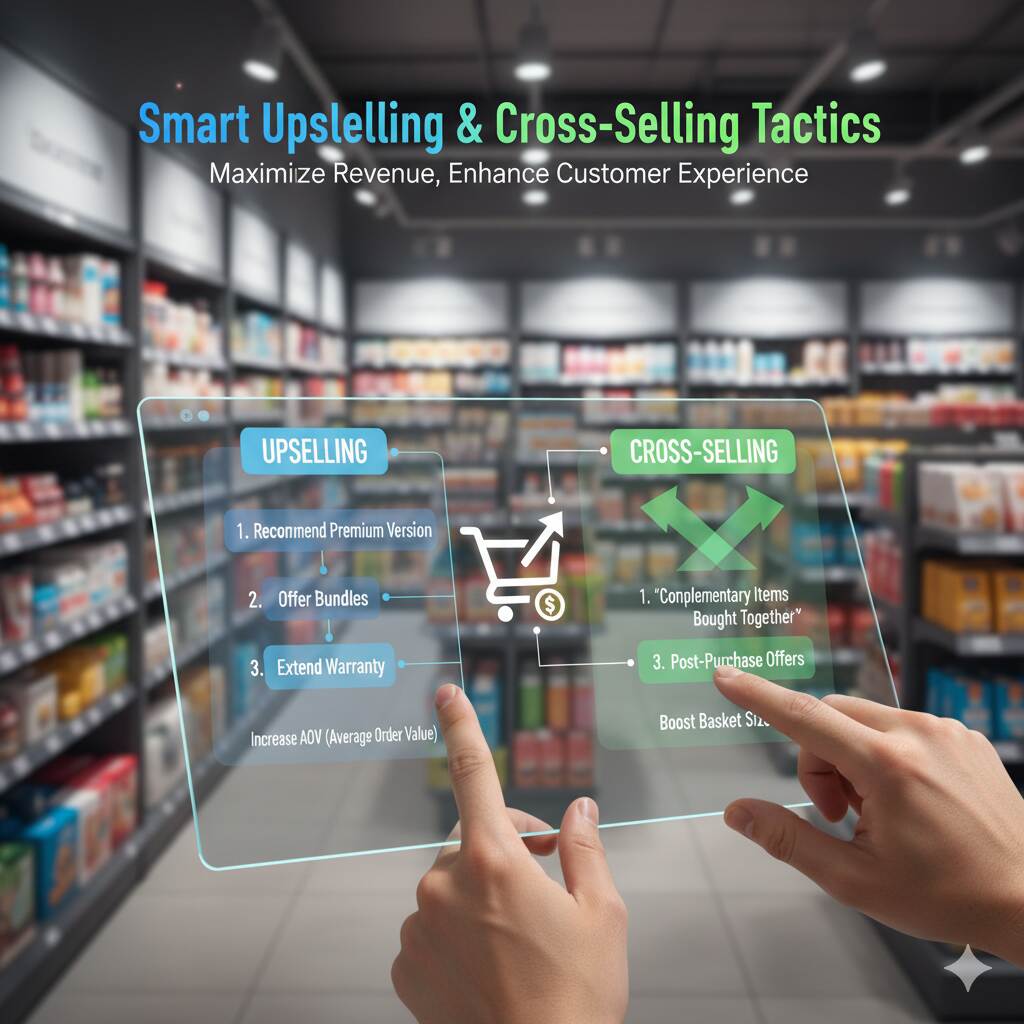In the world of e-commerce, increasing your average order value is just as important as attracting new customers. That’s where come in. However, here’s the challenge: how do you suggest additional products without coming across as pushy or manipulative?
The answer lies in subtlety, timing, and relevance. When done right, these techniques feel helpful—not salesy. In this guide, we’ll explore how to utilize effectively upselling and cross-selling online, fostering trust, enhancing the customer experience and driving revenue growth.
What Are Upselling and Cross-Selling?
Before diving into tactics, let’s clarify the difference:
- Upselling is encouraging customers to buy a more expensive version of the product they’re considering.
- Example: Suggesting a premium laptop with better specs when a customer is viewing a basic model.
- Cross-selling involves recommending complementary products that complement the item being purchased.
- Example: Offering a phone case or screen protector when someone buys a smartphone.
Both strategies aim to increase the customer’s lifetime value and improve their overall experience.
Why These Tactics Work
When done thoughtfully, upselling and cross-selling benefit both the business and the customer. Here’s why:
- Customers appreciate relevant suggestions that enhance their purchasing experience.
- You increase average order value (AOV) without spending more on acquisition.
- It’s easier to sell to existing customers than to acquire new ones.
- You build trust by showing you understand their needs.
But the key is to avoid being pushy. Let’s explore how.
Clever Upselling Tactics That Feel Natural
1. Focus on Value, Not Price
Don’t just push the pricier option—explain why it’s the better choice. Emphasise benefits such as durability, performance or long-term savings.
Example:
“Upgrade to our Pro Plan and save 20% annually while unlocking advanced features.”
2. Use Tiered Pricing
Show multiple options side-by-side. This helps customers compare and often nudges them toward the middle or premium tier.
Example:
Basic – $29/month
Standard – $49/month
Premium – $79/month
Most users will choose the middle option if it is the best value.
3. Offer Limited-Time Upgrades
Create urgency without pressure. A subtle time-bound offer can encourage upgrades.
Example:
“Get 50% off your upgrade for the next 24 hours.”
4. Personalise Recommendations
Use browsing history, cart contents or purchase behaviour to suggest relevant upgrades.
Example:
“You’ve added a DSLR camera. Want to upgrade to the bundle with extra lenses and a tripod?”
5. Use Post-Purchase Upsells
Don’t interrupt the buying process. Instead, offer upgrades after the purchase is complete.
Example:
“Thanks for your order! Want to add a 2-year warranty for just $19?”
Cross-Selling Tactics That Feel Helpful
1. Bundle Products
Create product bundles that make sense together. This simplifies decision-making and adds value.
Example:
“Buy the gaming console with two controllers and a popular game—save $30.”
2. Show ‘Frequently Bought Together’
This Amazon-style tactic works wonders. It’s based on real customer behaviour and feels organic.
Example:
“Customers who bought this laptop also bought a wireless mouse and laptop sleeve.”
3. Use In-Cart Suggestions
While the customer is reviewing their cart, suggest complementary items to enhance their purchase.
Example:
“You’re buying running shoes. Add moisture-wicking socks for just $9.”
4. Offer Add-Ons at Checkout
Please keep it simple and relevant. Don’t overload the checkout page—just one or two helpful suggestions.
Example:
“Add a screen protector for $5 to keep your phone scratch-free.”
5. Follow Up with Email Cross-Sells
Use post-purchase emails to suggest accessories or related products.
Example:
“Thanks for buying your new camera! Here are some must-have accessories to get the most out of it.”
Tools to Automate Upselling and Cross-Selling
You don’t have to do it manually. Here are some tools that make it easy:
- Shopify Apps: Bold Upsell, ReConvert, Frequently Bought Together
- WooCommerce Plugins: Cart Add-ons, Product Bundles
- BigCommerce: Built-in upsell and cross-sell features
- Email Marketing Tools: Klaviyo, Mailchimp, Omnisend
These tools enable you personalise offers, track performance, and optimise your strategy.
Best Practices to Keep It Non-Pushy
1. Keep It Relevant
Only suggest products that genuinely complement the customer’s choice. Irrelevant suggestions feel spammy.
2. Don’t Overwhelm
Limit suggestions to 1–3 items. Too many options can lead to decision fatigue.
3. Respect the Customer’s Journey
Don’t interrupt the buying flow. Place upsells and cross-sells where they feel natural—on product pages, in the cart, during checkout or after purchase.
4. Use Clear Language
Avoid aggressive sales language. Instead of “You need this,” try “You might like this.”
5. Test and OptimizeOptimizeOptimize
Use A/B testing to see what works—track metrics like conversion rate, AOV and bounce rate.
Real-Life Example: How a Fashion Brand Increased AOV
A mid-sized fashion brand used cross-selling to boost revenue. They added “Complete the Look” sections on product pages, suggesting matching accessories.
Results:
- AOV increased by 25%
- Cart abandonment dropped by 15%
- Customers reported higher satisfaction
They didn’t push—they simply helped customers make better choices.
FAQ: Upselling & Cross-Selling Online
Q1: What’s the difference between upselling and cross-selling?
A: Upselling promotes a higher-end version of the product. Cross-selling suggests complementary items.
Q2: When is the best time to upsell?
A: Post-purchase or during checkout works best. It feels less intrusive and more helpful.
Q3: How do I avoid annoying customers?
A: Keep suggestions relevant, limit the number, and use friendly language.
Q4: Can I use these tactics in email marketing?
A: Absolutely. Post-purchase emails are perfect for cross-selling accessories or upgrades.
Q5: Do upselling and cross-selling work for digital products?
A: Yes. You can upsell premium plans or cross-sell add-ons, such as templates, plugins, or support packages.
Final Thoughts
Upselling and cross-selling online don’t have to feel pushy. When done with empathy and relevance, they enhance the customer experience and drive revenue. The secret is to offer value—not just more stuff.
Start small, test your approach, and always prioritizeprioritizeprioritize the customer’s needs. With the right strategy, you’ll build trust, boost sales, and create loyal fans who appreciate your thoughtful suggestions.

